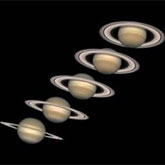The Real Lord of the Rings
 Why is Saturn the only planet with bright, easily seen rings? Saturn is not the only planet in our solar system with rings. Jupiter, Neptune and Uranus all have rings. Jupiter's rings are much smaller and very dark when compared to Saturn's rings. Jupiter's rings could be much older than Saturn's rings if the idea is correct that the particles would become dull as space dust sticks to them. Neptune and Uranus have very dark, almost black, rings. Scientists have said that these three planets' rings might have formed after collisions with meteorites or asteroids that sent dirt and rocks into orbit around these planets. So, whatever formed Saturn's rings may not have happened to any other planet in a very long time.
Why is Saturn the only planet with bright, easily seen rings? Saturn is not the only planet in our solar system with rings. Jupiter, Neptune and Uranus all have rings. Jupiter's rings are much smaller and very dark when compared to Saturn's rings. Jupiter's rings could be much older than Saturn's rings if the idea is correct that the particles would become dull as space dust sticks to them. Neptune and Uranus have very dark, almost black, rings. Scientists have said that these three planets' rings might have formed after collisions with meteorites or asteroids that sent dirt and rocks into orbit around these planets. So, whatever formed Saturn's rings may not have happened to any other planet in a very long time.
How did the rings form? This question could have many possible answers. The size and shape of the rings give us some hints. The rings are very wide, 250,000 km, but very thin, only a few tens of meters (about 100 feet). If the rings started out as bits of matter spread over a large area, over time collisions could have slowly 'collapsed' them into flattened rings. And the rings certainly are flat! If you imagine a model of Saturn one meter wide, the rings would be only 1/10,000 the thickness of a razor blade. Wow!
Another possible origin is one of Saturn's moons that was destroyed by a collision. The dirt and rocks from that moon spread into the rings. Keep in mind that the rings are like a flat plate that cuts Saturn in two halves as if all of the pieces were originally orbiting in one plane. The pieces of stuff that make up the rings of Saturn range in size from microscopic dust to barn-size boulders. This big difference in size of the pieces of the rings fits either of the two theories about the formation of the rings.
About the Author
NASA Marshall Space Flight Center
 The George C. Marshall Space Flight Center, located in Huntsville, Alabama, is the U.S. government's civilian rocketry and spacecraft propulsion research center. As the largest NASA center, MSFC's first mission was developing the Saturn launch vehicles for the Apollo program.
The George C. Marshall Space Flight Center, located in Huntsville, Alabama, is the U.S. government's civilian rocketry and spacecraft propulsion research center. As the largest NASA center, MSFC's first mission was developing the Saturn launch vehicles for the Apollo program.


